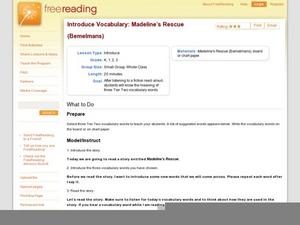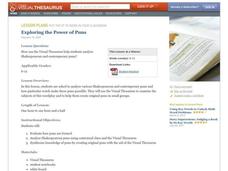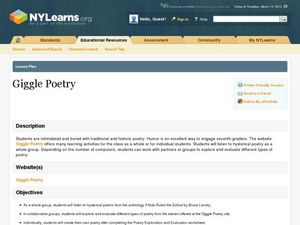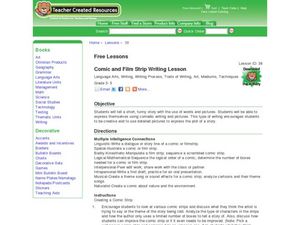Scholastic
Test-Taking Strategies for Three Subject Areas
Sometimes a test page loaded with text can make a student's face go blank. Help them decipher what a text question is asking with a series of tips focused on reading comprehension, vocabulary, and language arts mechanics.
California Department of Education
Evaluating Web Sites
If it's on the Internet, it must be true—right? How can someone tell if a website contains less-than-truthful information? Savvy surfers evaluate sources in the fifth of a six-part college and career readiness instructional activity...
Council for Economic Education
Understanding a Balance Sheet
Read any financial website or book, and it is bound to discuss the words asset and liability. But what do these words actually mean to the class? The resource effectively explains by using multiple formats and techniques, including...
Southern Illinois University
I Can Write a Poem
It is so important for English language learners to be able to write for a variety of purposes. Specifically written for an ELD class, this activity provides explicit instruction for teaching learners how to write a poem. First, they...
Curated OER
New Vocabulary: The Ugly Duckling
The class hears the story of The Ugly Duckling to build vocabulary. They hear the story, then pull three to four vocabulary words from the text. The teacher then helps them use the context of each sentence to construct a meaning for each...
Curated OER
Introduce Vocabulary: Madeline's Rescue (Behelmans)
What new adventure is Madeline on now? Emerging readers expand their vocabulary in Ludwig Behelmans' story Madeline's Rescue. Although there are many words you could focus on here, five have been furnished with comprehension...
Curated OER
Exploring the Power of Puns
Read and analyze a variety of Shakespearean and contemporary puns using Visual Thesaurus computer software. Middle and high schoolers analyze a pun as a class; in small groups they analyze a Shakespearean pun using contextual clues and...
Curated OER
Reading Picnic
Students fill in the amount of minutes read nightly and any new words they come across. At the end of the month they have a "Reading Picnic." students bring their favorite book, snack, drink, and sheet.
Curated OER
Giggle Poetry
Poetry can be fun! To set your pupils giggling, have them listen to poems from If Kids Ruled the School by Bruce Lansky. Then, they can study the different types of poetry on www.gigglepoetry.com, and choose one form on which to...
Curated OER
Limericks
Fourth graders look up the definition of "Limerick" in the dictionary. They listen to the teacher explain a limerick and read an example of a limerick. Students brainstorm rhyming words and write their own limericks.
Curated OER
Fables With Dolch Sight Words
Second graders read classic fables, consider their meaning and then re-write them using a prompt if necessary. This lesson plan presents many classic fables that students can read, and re-write, using their powers of imagination.
Curated OER
The Rumpelstiltskin Story
Why didn't Rapunzel's hair stop growing? Why did it take the fairy godmother so long to intervene in Cinderella's affairs? Young writers consider unanswered questions like these and compose news articles investigating the true...
Curated OER
Comic and Film Strip Writing
Students write a funny story and illustrate it in a comic strip. In this comic strip lesson, students study comic strips and determine the plot of each story. Students then write a short story and illustrate it using a comic strip...
Curated OER
Writing for Different Purposes and Audiences
Third graders explore how to write for different purposes and for a specific audience or person. They read, Where the Wild Things Are by Maurice Sendak. Students create a class book after reading the story. They each create their own...
Curated OER
Anansi Goes to Lunch
Second graders read the story Anansi Goes to Lunch and complete language arts activities connected to the story. In this language arts lesson plan, 2nd graders complete activities including discussion, reading, writing, drawing, and role...
Curated OER
How Many? How Much?
First graders recognize and learn the value of coins. In this instructional activity on money, 1st graders read the book Monster Money by Grace Maccarone, discuss the role of money in society, identify various coins, and explore making...
Curated OER
The Mitten
Learners read the book, The Mitten and make a list of animals that moved into the mitten. In this literature lesson, students discuss why we like to have nice, warm places to live, and what happens when there isn't enough space for...
Curated OER
Solving Multi-Step Equations (Ch. 2.3)
Eighth graders solve multi-step equations, showing each step in their solution. This multi-step equations lesson includes sample problems to complete as a class, clear step by step instructions for the student and a linked comic strip...
Curated OER
Mrs. Perkins Dolch Words: #10 Create a Story
Students write their stories. In this sight words and writing instructional activity, students examine a list of 20 teacher-provided dolch words and use them to write their own stories. Students share their stories with their...
Curated OER
High Frequency Words with Clip Art
Second graders invent sentences using high frequency words. In this literacy lesson, 2nd graders type simple sentences using high frequency words, and a clip art picture for each sentence.
Curated OER
Introduce Vocabulary: Madeline’s Rescue
Students explore language arts by reading a children's book in class. In this story vocabulary lesson, students read the book Madeline's Rescue and identify the use of specific vocabulary words. Students define vocabulary terms and...
Curated OER
Autobiography
Sixth graders read and write autobiographical sketches, determine the author's purpose in writing, and type paragraphs using WP utilities.
Curated OER
Nuts and bolts
Students work in groups to create a storyboard about their video. They shoot a video designed to teach others to connect the computer and camcorder and how to capture video in Adobe Premiere Elements editing program.
Curated OER
Clown Accordion Book
Students investigate the letters that form the word "clown". They draw the pictures that coincide with each letter. Students use construction paper for a background and then insert the pictures. Then they write the dialogue for the book.























